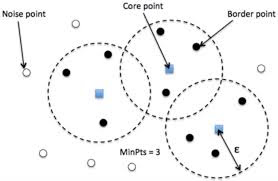DBSCAN Clustering
DBSCAN (Density-Based Spatial Clustering of Applications with Noise)
Why we need DBSCAN?
While K-Means clustering is a popular choice, it struggles with noisey data as it considers outliers as a cluster. Enters DBSCAN, an algorithm that not only detects the outliers but also removes them.
So now, let's understand, How this algorithm works?
.png)
Key Ingredients of DBSCAN
- Epsilon (ε): Think of this as the maximum distance between two points for them to be neighbors.
- MinPts: The minimum number of points required to form a dense cluster.
- Core Point: A point with at least MinPts neighbors within its ε-radius.
- Border Point: Close to a core point but with fewer than MinPts neighbors.
- Noise Point: Points that don’t fit into any cluster – the outliers.
Why Choose DBSCAN?
- Outlier Detection: Naturally identifies noise points, making it great for spotting anomalies.
- No Predefined Clusters: Unlike K-Means, you don’t need to specify the number of clusters beforehand.
- Flexibility: Handles clusters of various shapes and sizes, perfect for complex datasets.
Tips for Tuning DBSCAN
Choosing the right values is key:
- Epsilon (ε): A small
epsmight leave many points as noise, while a largeepscould merge distinct clusters. Plot the k-distance graph to find the "elbow" point – a sweet spot foreps. - MinPts: Typically set to twice the number of dimensions. Adjust based on your data and domain knowledge.



Comments
Post a Comment